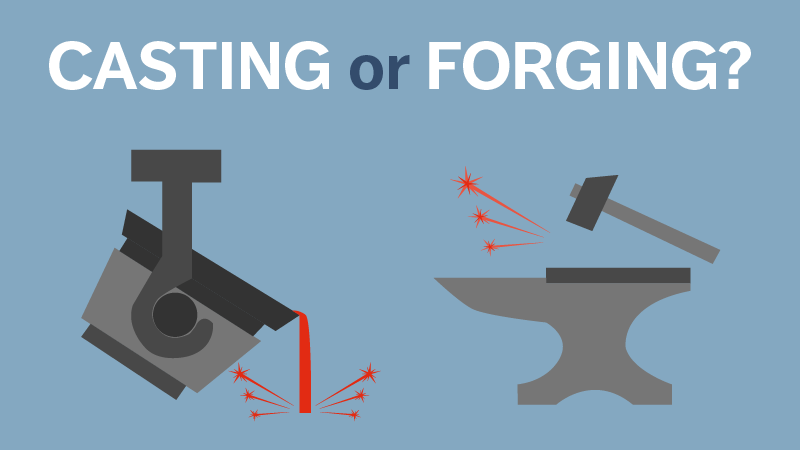What is the difference between forging, stamping and casting?
1. Difference between forging and casting
(1) Conceptual difference
Casting: it is to change the metal liquid without shape into a solid with shape.
Forging: it is a solid that changes one shape into another.
Casting is like playing with wax. You buy Wax (scrap steel, or pig iron) and then turn the wax into liquid and put it into a mold, so you can get things of different shapes. (solid liquid solid)
Forging is like the process of making bread. You knead the small dough and put it into the mold to make products of different shapes. Almost solid. At high temperature, the shape can change into other shapes (solid to solid).
Casting is the process of casting molten metal into a model to obtain a casting. The casting specialty focuses on the metal smelting process and the process control in the casting process.
Forging is plastic forming under solid state. It can be divided into hot processing and cold processing, such as extrusion, drawing, thick pier, punching, etc.
(2) Forging is slow forming, casting is one-time forming.
Casting: molten liquid metal fills the mold cavity for cooling. Pores are easy to occur in the middle of the parts.
Forging: it is mainly formed by extrusion at high temperature. It can refine the grains in the workpiece.
2. Difference between free forging and die forging
Free forging is a processing method in which the heated metal blank is placed between the upper and lower iron of the forging equipment, and the impact force or pressure is applied to directly produce plastic deformation of the blank, so as to obtain the required forging. Free forging is suitable for the production of single piece, small batch and heavy forgings because of its simple shape and flexible operation. Free forging is divided into manual free forging and machine free forging. Manual free forging has low production efficiency and high labor intensity. It is only used for repair or the production of simple, small and small batches of forgings. In modern industrial production, machine free forging has become the main method of forging production, and it plays a particularly important role in heavy machinery manufacturing.
Die forging is fully called model forging. The heated blank is placed in the forging die fixed on the die forging equipment for forging.
Die forging can be carried out on a variety of equipment. In industrial production, steam air hammer is mostly used for die forging on hammer, with tonnage of 5kn ~ 300KN (0.5 ~ 30t). Hot die forging press is commonly used for die forging on press, with tonnage of 25000kN ~ 63000kn.
The forging die structure of die forging includes single die hall forging die and multi-mode bore forging die. As shown in Figure 3-13, it is a single die forging die, which uses dovetail groove and wedge to fix the forging die to prevent falling out and moving left and right; The matching of key and keyway makes the positioning of forging die accurate and prevents forward and backward movement. The single die chamber is generally the final forging die chamber. Air hammer is often required for forging, and then it is formed by multiple hammering of the final forging die chamber. Finally, take out the forging and cut off the flash.
3. Differences among casting, forging, stamping and die casting
(1) Casting is to melt raw materials and let them form naturally in the forming mold;
Forging is heating raw materials to a certain temperature and then forging with tools;
Stamping is the stamping of raw materials with appropriate stamping dies;
Die casting is to inject the melted raw materials into the mold by pressure on the basis of casting to obtain higher density or more precise shape;
Casting: molten liquid metal fills the mold cavity for cooling. Pores are easy to occur in the middle of the parts.
(2) Forging: it is mainly formed by extrusion at high temperature, which can refine the grains in the workpiece.
Stamping with basically the same thickness of parts, which is suitable for forming with plates.
Parts with great thickness, complex shape and no heating shall be die cast.
1. There are two kinds of casting: high-pressure casting and low-pressure casting. In short, after melting the metal, the pressure is different, and the temperature of heating the metal is different from the machine used for casting
2. Forging is also a way of casting. The difference is that the temperature during forging is lower. Some methods can make metal into finished products in semi molten state
3. Stamping is the process of making semi-finished products into finished products with punch and other machines at room temperature
4. Die casting is also a way of high-temperature casting. When encountering castings with complex structure and great difficulty, a die casting machine can be used to heat the metal into liquid state, press it into the mold, open the mold after cooling, and take out the product.

ZheJiang Dongrun Casting Industry Co,.Ltd was built in 1995, We have been in the casting industry for more than 25 years. No matter what type of molding you need done, we are the right supplier for your jobs. Unlike other of our competition, we offer four types of castings.
Dongrun Casting have 20000 square meters facility houses and 200 production & test equipment, From quotation and tooling design to casting and finished machining, we can work with you at every stage. We serves wide range of industries-from Fortune 500 corporations to small and midsize OEMs. Our products includes:
❖ HVAC | ❖ Architectural parts |
Browse our online showroom to see what we can do for you. And then E-mail:dongrun@dongruncasting.com us your specifications or inquiries today
